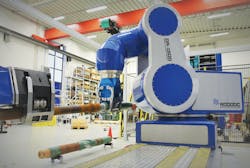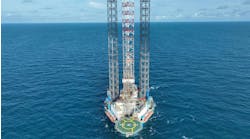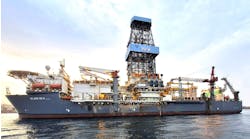Industrial communication is a key enabler of digitalization
Olmo Castaneira Rios
Siemens AG
Multi-axial drill floor robot designed for handling pipes and drill heads. (Image courtesy Robotic Drilling Systems AS)
Health, safety, security, and environmental concerns are major aspects driving oil and gas drilling companies worldwide. They need to comply with environmental legislation, but they are also focused on improving the safety of workers in the field while ensuring reliable platform operation.
Because global energy markets are characterized by increasing demands and now decreasing profits, drilling companies are also challenged with reducing the overall costs of their operations. Offshore drilling requires a highly qualified workforce and includes high operating expenses. Offshore workers need to be especially certified, which translates into substantial labor costs. They frequently need to be transported to and from the platform by helicopter, which results in high transportation costs.
Another factor is the time needed until first gas or oil. The shorter this time, the more profitable the drilling project. This means that companies are interested in increasing the efficiency of their operations by improving the reliability and availability of the hardware used.
There are also environmental issues that call for efforts to minimize the footprint of the operation, reduce the amount of energy needed, and prevent accidents that might have a detrimental effect on the environment.
As the automotive industry has demonstrated, replacing manual work by handling robots is not only a step toward lower operating costs, but also it leads to a higher level of quality and repeatability.
Reducing manual operations with robotics
The oil and gas industry has entered the world of automation and digital process control. Stavanger, Norway-based Robotic Drilling Systems AS (RDS) and Siemens have teamed up to develop a drill floor solution comprising robotic technology for fully unmanned oil and gas operations.
The system is designed to automate the complete drilling process. It handles the pipes and tools required, and can be integrated into new or existing onshore and offshore installations.
The system consists of drill floor robots, robotic roughnecks, multi-size elevators, and robotic pipe handlers. It is designed to remove high-risk manual tasks from the platform, while adding a new level of speed, accuracy, and reliability to drilling operations.
According to COO Jimmy Bostrøm, “The RDS solution enables oil and gas operators to decrease rig time per well, reduce health, safety and environmental incidents, while reducing operating costs through consistent operations. Additionally, the system offers benefits, such as faster installation, along with lower noise and energy consumption.”
The technology not only reduces the personnel costs associated with the rig, it also redefines the role of the drilling crew. The focus will change from drill floor tasks to the well construction process.
Industrial automation, control, and communication
Handling robots require intelligent motion control and a complex automation system to seamlessly work together to handle a complete work process without human intervention. Siemens provided RDS not only with a wide range of drives and the complete automation and communication system, but also with ongoing consulting and technical support.
Each of the robots is equipped with its own digital control system accommodated in a control cabinet. Here is where Simatic IPC’s with Simatic Step 7 software interpret sensor signals, translate process commands into motion control sequences and coordinate the interaction of related robots. They provide the digital intelligence required for handling pipes, positioning and attaching tools, and drilling.
Managed Scalance X switches provide communication between robots and the control room. (Image courtesy Siemens AG)
At the machine level, Siemens drives are combined with Sinamics 120 frequency converters, Simatic S7-300 controllers, and Simatic ET 200 distributed IO systems. They form a decentralized machine control system that links all the mechanical processes on the drill floor to the digital world. In the control room, WinCC Advanced is used to visualize all the processes via Simatic HMI panels, and allows especially trained technicians to monitor and control drilling without manual intervention.
The communication between the control room and the robots and between the robots themselves is established using industrial communication products from the Scalance S and Scalance X range. The Scalance Industrial Ethernet switches ensure that data is reliably transmitted between the various automation, drives, and visualization components. These switches are designed to be deployed in extremely harsh environments and support critical applications such as drilling.
Siemens’ portfolio of Scalance switches comply with a broad spectrum of approvals required in the oil and gas industry. For example, ATEX, FM, IECEx and UL HazLoc approvals for use in hazardous areas, as well as ABS, BV, DNV GL, and LR for marine applications. The Scalance X-200IRT managed Industrial Ethernet switches, operating in isochronous real time, have been specifically designed for stringent real-time applications. They can be used for high-performance machine-level applications all the way up to networked plant sections in Profinet environments.
Fully automatic and unmanned operation on the drill floor. (Image courtesy Robotic Drilling Systems AS)
The security modules of the Scalance S family have been specifically designed for use in automation environments, yet connect seamlessly with the security structures of the office and IT world. They ensure security, and meet the special requirements of automation engineering. For instance, existing systems can be simply upgraded, installation is straightforward, and downtime is minimized in the event of a fault. Various security measures can be combined depending on the security requirements.
This explains why industrial communication is a key enabler of digitalization in the oil and gas industry, as it is necessary to ensure a reliable, secure, and continuous data transmission along the complete drilling value chain.
Conclusion
With its robotic drilling system, RDS has brought oil and gas drilling operations into the digital age. It can be used on newbuilds or retrofitted to existing rigs. Early studies indicate potential savings of up to 40 rig days per year per rig. Beyond decreasing rig time, improving HSE and reducing operating costs, a full robotic system provides other benefits, such as less downtime, faster installation, lower noise and energy consumption, and reduced CO2 emissions.
The system replaces labor-intensive, costly and potentially dangerous manual processes using handling robots that seamlessly interact with one another. This not only reduces costs while improving reliability, equipment availability and environment protection, it also paves the way for oil and gas operations to evolve.
Robot-based drilling operations will generate a wealth of process data that can be used to better understand and optimize the drilling process.
According to Bostrøm: “We anticipate an industry-wide convergence of automation and robotics by 2020. Automatic drilling and drill floor handling will be combined with downhole data acquisition to optimize all of the key parameters from crown block to downhole.”






